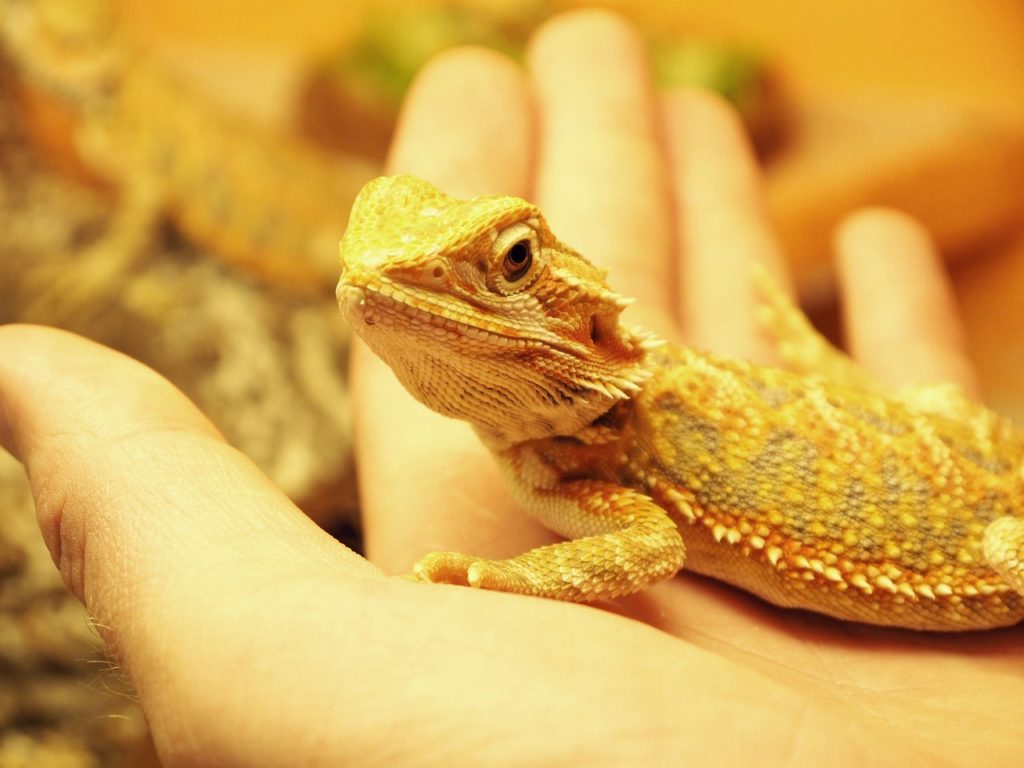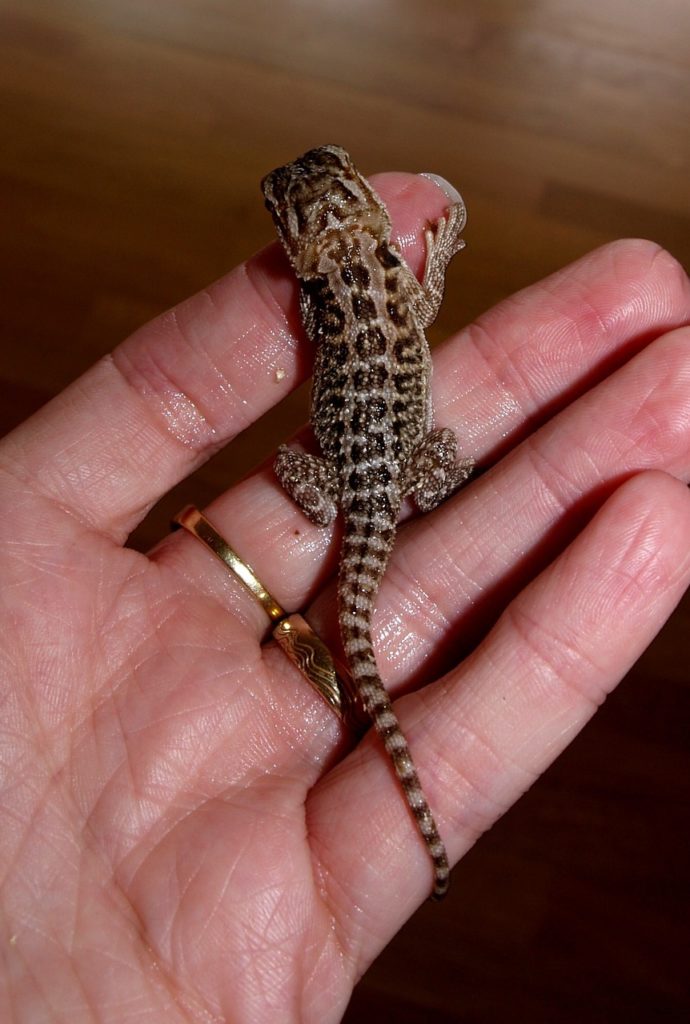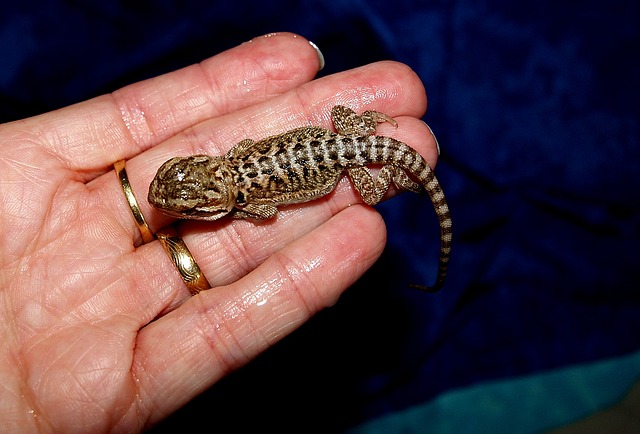A substantial part of the appeal of bearded dragons relates to their laid-back, docile personalities.
Combined with their nearly ideal body size, this makes them some of the most enjoyable lizards to handle in the reptile-keeping hobby.

Typically, bearded dragons don’t mind interacting with humans and they’ll tolerate regular, brief handling sessions without becoming stressed or objecting very much.
Nevertheless, you’ll still need to be careful to handle your bearded dragon in the appropriate manner to ensure he doesn’t become injured or begin suffering from stress.
We’ll outline some of the dos and don’ts of bearded dragon handling below.
Employ these tips, and you and your pet should be able to enjoy years of fun interactions.
Quick Navigation
Do the Following When Handling Your Bearded Dragon

There are several things you’ll want to ensure you do when handling your bearded dragon.
Some of the most important things you should do include:
1. Lift Your Dragon Gently
Bearded dragons are pretty sturdy lizards who aren’t especially frail, but they can still be injured through rough handling.
This means you’ll want to lift your pet very gently, by first placing your hand or finger under his chin.
Then, apply gentle pressure upward, which will usually stimulate your lizard to climb onto your hand.
Alternatively, you can lift adult dragons by gently grasping them around the shoulders or hips and placing them in your outstretched hand.
Just be sure to grab your pet securely, but gently to make sure he neither falls nor feels unnecessary pressure around his body.
Support Your Lizard’s Body Weight
Once you’ve lifted your lizard and placed him in your hand, try to keep his entire body weight supported.
This will prevent him from feeling frightened, which may cause him to run or thrash about in an effort to feel more secure.
If you are a large person or your lizard is still small, you can likely support your lizard with one hand (and/or wrist).
But it is usually preferable to support large bearded dragons with two hands at a time for maximum safety.
2. Handle Your Bearded Dragon in Calm, Controlled Settings
Although bearded dragons are usually pretty laid-back lizards, who aren’t particularly reactive, you’ll still want to make sure that handling sessions take place in calm, controlled settings.
Typically, this will mean handling your bearded dragon in a closed room, in which there are no loud noises (including televisions, radios or similar devices).
It is also wise to limit the number of people in the room to help ensure your pet remains calm and isn’t stressed or frightened by all of the potential “predators” watching him.
3. Keep Handling Sessions Relatively Brief
Even the calmest bearded dragon will eventually become stressed out if you handle him for too long.
In fact, it is important to understand that bearded dragons probably do not “like” being handled – they simply “tolerate” it.
So, it is wise to avoid pushing their limits by keeping handling sessions relatively brief.
You don’t need to time your handling sessions or impose strict time limits, but generally speaking, you should keep handling sessions to about 10 or 15 minutes.
Obviously, there will be times when you’ll need to exceed this type of time frame (such as when taking your pet to the vet), but it is wise to avoid doing so whenever possible.
4. Clip Your Dragon’s Nails if They Bother You
Bearded dragons don’t have the formidable claws of a monitor lizard or large iguana, but they may still irritate and scratch your hands.
That’s usually not a big problem, but if it bothers you, simply clip your pet’s nails.
You can clip a bearded dragon’s nails in the same way you would a dog or cat’s nails.
You’ll just want to remove the pointy tip, without cutting through the quick (which is usually visible if you examine the nail in good lighting).
Just be careful that you don’t trim them too short, or it may hurt your lizard.
If you aren’t comfortable clipping your dragon’s nails, your vet or a reptile-oriented pet store will likely perform the task for a nominal fee.
5. Wash Your Hands Every Time You Touch Your Lizard
Bearded dragons are relatively clean when compared to aquatic turtles and some other common pet species.
However, they can be contaminated with a variety of pathogenic bacteria, including various strains of Salmonella.
If you’re not careful, you may end up ingesting some of these bacteria inadvertently, thereby causing yourself to become very sick.
Fortunately, you can usually avoid illness by simply washing your hands after handling your dragon (or anything in his enclosure).
Just use plenty of soap and warm water and be sure to scrub the areas where dirt and bacteria often linger, such as around your fingernails.
You needn’t use antibacterial soap – ordinary hand soap will wash the bacteria off your hands.
Note that young children, elderly individuals and those with compromised immune systems may be at increased risk of illness.
So, do not allow young children to handle bearded dragons, and be sure that others who may be at increased risk of illness speak with their physician before handling any reptile.

Do NOT Do Any of the Following When Handling Your Bearded Dragon
In addition to the things explained above that you should do when handling your pet, you should avoid doing any of the following:
Hold Bearded Dragons Until They’re at least 6-inches Long
Bearded dragons are pretty robust lizards once they’ve achieved a bit of size, but hatchlings are pretty fragile for their first month or two.
It is extremely easy to injure them during this time, and they’re also quite flighty, which can cause them to leap off your hand with little warning.
As a rule of thumb, you’ll want to avoid any unnecessary handling until your bearded dragon is about 6 inches long or so.
By this time, they’re usually sturdier and less likely to become injured during handling sessions.
They’ll also have calmed down a little, making them easier to handle in the first place.
Stare at Your Lizard While Trying to Gather Your Nerve to Pick Him Up
Bearded dragons are generally very placid lizards, who are disinclined to bite the hands that feed them (though there are certainly exceptions).
However, many fledgling keepers are still nervous about the notion of picking up or handling their new pet.
This often causes such keepers to stare at their lizard for long periods of time, while they try to work up the courage to pick up their dragon.
But this is something you should strive to avoid doing. This can not only frighten your lizard, which can lead to stress and anxiety, but it will also increase the chances that your lizard will react negatively to your hand.
So, when you intend to handle your dragon, do so deliberately and without hesitation. This will lead to a much better interaction for you and your pet.
Grip or Restrain Your Lizard (Unless Necessary)
When handling your bearded dragon, the best approach is to simply serve as a platform for your pet.
In other words, you want to allow him to hang out or walk on your outstretched hands and arms – you do not want to grip his body.
This will not only prevent him from moving freely, but it’ll also usually cause your lizard to become quite anxious.
This will not only condition your lizard to dislike handling sessions, but it’ll also increase the chances of your lizard reacting negatively toward you.
It may also cause them to struggle and writhe around in an attempt to escape.
On those rare occasions in which you need to restrain your pet (such as to examine an injury), just be sure to do so with the lightest touch possible. Also, be sure to release your grip as soon as you possibly can.
Handle Your Bearded Dragon Around Other Pets
Your bearded dragon will learn over time that you don’t pose any threat to him, which will help ensure he remains docile during handling sessions.
However, your cat or Labrador retriever will not have the same type of relationship with your dragon.
Other pets may not only frighten your lizard, which may cause him to try to run away or struggle, but they may injure him if given the chance.
This is especially true of cats, but the family dog may also snatch up your dragon and run off to play with his new “toy.”
Accordingly, it is important to avoid handling your bearded dragon (particularly if it is a young or small animal) around any of your other pets. This can also include other reptiles, who may also act aggressively or cause anxiety for your dragon.
Lift Your Bearded Dragon by the Tail
Unlike some other lizards, bearded dragons do not autotomize their tails.
Some individuals may suffer injuries to their tail or lose them entirely, but bearded dragons do not do so as a defense mechanism.
And if something does happen to their tail, the resulting injury will essentially be permanent.
Unfortunately, this causes some keepers to mistakenly assume that bearded dragons can be safely lifted by the tail. But this is definitely not a good idea.
Your bearded dragon’s tail is unlikely to break off if you do so, but it will put undue stress on his tail and entire spinal column.
In a worst-case scenario, this could cause your pet to become paralyzed or suffer other serious injuries.
So, avoid picking your bearded dragon up by the tail, and instead lift him as described earlier.
Handle Your Bearded Dragon Too Often
As long as your bearded dragon is healthy and doesn’t appear especially troubled by human interaction, it is fine to handle him regularly.
In fact, it’ll help reinforce your relationship and keep his stress level lower whenever you do need to interact with him.
This can be very valuable when having to examine or treat lizards who fall ill.
But excessive handling is another issue entirely. If you handle your lizard too often, he’ll likely suffer from stress, which will make him more susceptible to health problems and illness.
It is difficult to make broad generalizations about the acceptable handling frequency for bearded dragons.
However, a safe rule of thumb is that you shouldn’t handle your lizard more than once each day.
Even then, it is still wise to give him a day or two each week where you do not touch him at all.
Hold or Handle Gravid Bearded Dragons
Bearded dragons are often quite easy to breed, and many keepers eventually decide to try their luck at captive reproduction.
As long as you have all of the necessary resources to do so, as well as a plan for finding homes for all of the hatchlings (a large female bearded dragon may produce 100 or more offspring each year), there’s nothing wrong with starting a breeding program.
However, it is important to treat gravid females very gently during the breeding process, to avoid injuring them or damaging the eggs they’re carrying.
This means that it is usually advisable to avoid handling bearded dragons who may be carrying developing eggs.
From time to time, it may be necessary to handle gravid females, but you’ll want to limit these occasions and do so with as much care as is possible.
Handle Your Bearded Dragon Immediately After He Eats
A lot of reptile keepers are aware that it is inadvisable to handle snakes immediately following meals.
But it is actually a bad idea to handle any reptile immediately following a meal – including bearded dragons.
Bearded dragons who are handled immediately after a big meal are unlikely to be terribly comfortable during the process.
It may even cause them to vomit in some cases.
This doesn’t mean you have to avoid handling your pet because he ate a cricket a half-hour ago, but you should give him several hours to digest his food following large meals.
The same principle applies to bearded dragons who’ve just consumed a lot of water.
In fact, bearded dragons who’ve recently filled their bellies with water will often regurgitate some of it when handled.
Final Thoughts
Handling your bearded dragon isn’t terribly difficult, and given their pleasant personalities, it is usually a fun way to interact with your pet.
Just be sure to follow the dos and don’ts discussed above and you’ll be able to avoid most problems that may arise.